Athletic Club de Madrid, known as Atlético de Madrid, has a story full of passion and determination – a journey that has captivated football fans across the globe. Since their beginnings in 1903 as a parent Club Athletic Bilbao (I’ll tell you a little more next!), until their rise as one of the most successful and beloved clubs in Spanish football, Atlético’s legacy is stuffed with unforgettable moments, legendary players, and amazing rivalries like the iconic Madrid Derby.
Whether you’re a supporter or new to the world of Los Rojiblancos, this article dives deep into the club’s history, exploring its triumphs, challenges, and the spirit that makes it one of the most famous teams in football.
Come with me to discover the incredible story of Club Atlético de Madrid, and then tell me if you’re a fan of the club!
Table of Contents:
- History of Atletico Madrid: A Journey of Triumph, Passion and Football
- Early Years: Birth of Club Atlético de Madrid
- Context of Early 20th Century Football in Spain
- Red and White Stripes
- Independence and Growth
- Surviving the Spanish Civil War
- New Identity and Ambitions
- The Growth of Athletic Club de Madrid (or Atlético Madrid)
- Post-Civil War Rebuilding
- First Major Trophy
- Latin Cup and International Glory
- Rise of Atlético Madrid in La Liga and European Glory
- First European Glory
- Rivalry with Real Madrid and Madrid Derby
- Consolidation and Continuous Success
- 1980s: Period of Transition
- 1990s: Challenges and Triumphs
- 2000s and 2010s: Simeone’s Revolution
- Recent Years
- The Future: Atlético’s Ambitions
- Crises and Comeback (1990-2010)
- Simeone Era
- Iconic Players and Rivalries
- Stadiums and the Passion of the Fans
- Make Your Own History with FootballTeam Game
Early Years: Birth of Club Atlético de Madrid
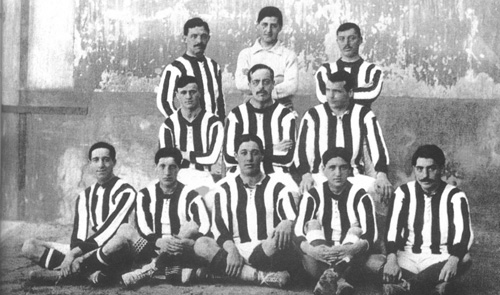
Atlético Madrid’s story began on April 26, 1903, when three Basque students living in Madrid – inspired by their beloved Athletic Bilbao – decided to create a branch of their parent club in the Spanish capital. They named the club Athletic Club de Madrid, with the intention of extending Bilbao’s footballing philosophy and passion to a new region.
This initiative marked the beginning of what would become one of the most iconic teams in Spanish football. From the start, the club’s founders showed their ambition, seeking to create a team that couldn’t only compete in Madrid but also challenge the footballing dominance of larger cities in Spain.
Context of Early 20th Century Football in Spain
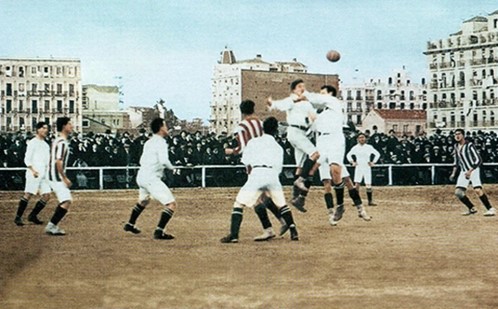
At the time of its founding, football in Spain was still a developing sport, overshadowed by other traditional sports like bullfighting and pelota. The country didn’t have a structured football league, and most clubs were still in their “childhood.” For Atletico de Madrid, the early years were difficult, with limited resources and basic facilities.
Matches were played on improvised pitches, with no more than the minimum of equipment, and the club’s players were amateurs with day jobs outside of football. However, despite these beginnings, the club’s founders were determined to make their mark.
Initially, Athletic Madrid adopted the blue and white stripes of its parent club, mirroring Athletic Bilbao in style and identity. The early team was composed mainly of Basque players, who were essential to the club’s early success, bringing their skill and football knowledge to the capital.
These players quickly established the club as a competitive team, even though the resources available to them were limited compared to larger teams. Their ambition was evident, and that made it clear that the club wouldn’t settle for little.
Red and White Stripes
In 1911, a significant change occurred that would shape the identity of Athletic Madrid forever. The club switched to red and white stripes, a decision born out of practicality rather than design. The club fought to find a suitable uniform, but the availability of red and white fabric – used for making bed mattresses – led to this change.
This alteration set the club apart from its Basque roots and marked the beginning of its new identity. The red and white shirts became a symbol of the club and desire to overcome challenges, and they became a recognizable part of the Atlético Madrid identity.
This change marked the start of a new era for the club. The adoption of the red and white stripes earned the team the nickname “Los Colchoneros”, a term that would later be embraced by fans as a representation of the club’s working-class roots and enduring spirit.
The red and white colors became synonymous with Atlético’s passionate fanbase, who saw the club as a football team and a symbol of their own aspirations.
Independence and Growth
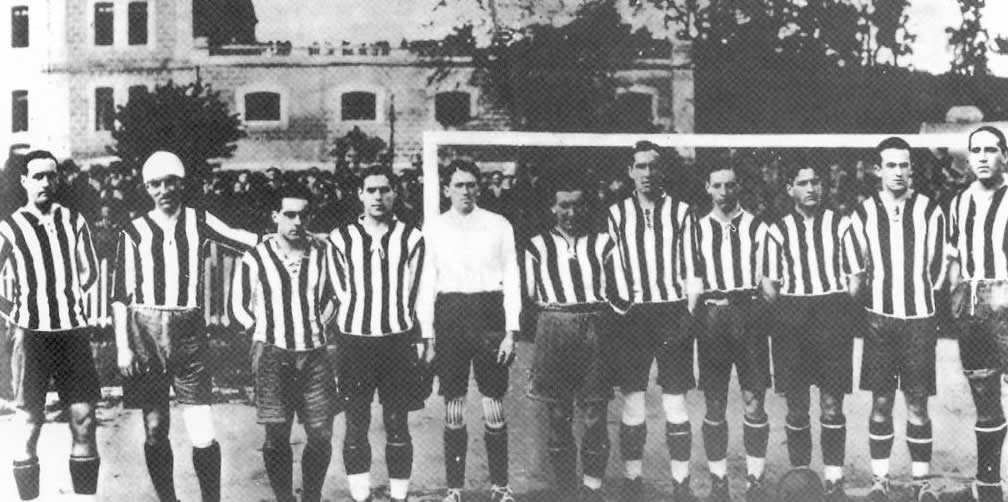
By 1921, Athletic Club de Madrid took steps towards independence, cutting ties with Athletic Bilbao to become an independent team. This decision was driven by a desire to establish a unique identity that could represent Madrid’s culture and people, differentiating itself from its Basque part.
The name was officially changed to Atlético de Madrid, showing the beginning of a new chapter in the club’s history.
This change allowed the club to guide its own course in Spanish football. In the following years, Atlético Madrid began to grow, attracting new players and fans, and developing a reputation as a hardworking team. The decision to break away from Athletic Bilbao marked the beginning of a new era, with Atlético focused on developing its own traditions and legacy in Madrid.
This transition was key to the club’s success, as it allowed the team to build its own identity separate from its parent club, with an emphasis on local pride and dedication to the sport.
Surviving the Spanish Civil War
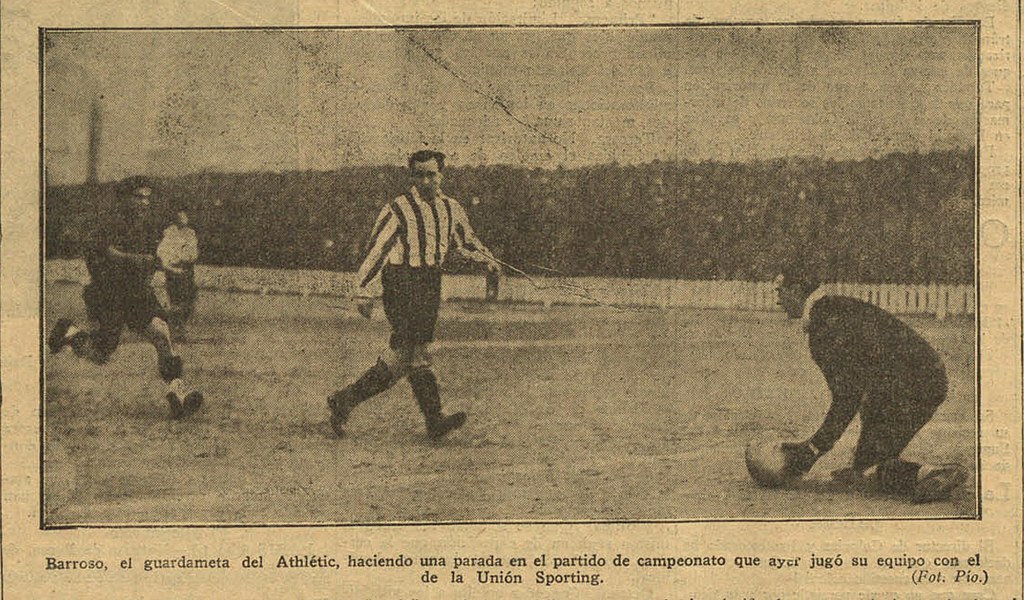
The Spanish Civil War in the late 1930s brought significant challenges for clubs across Spain, and Atlético Madrid was no exception. The war left the country in ruins, and football, like many other aspects of life, was severely disrupted.
Atlético, which had been a growing force in Spanish football, found itself having problems with financial instability, lack of players, and a lack of its own infrastructure. The club’s survival was far from guaranteed.
In a crucial move, Athletic Madrid merged with Aviación Nacional (the football team of Spain’s Air Force) in 1939, after the end of the war. This merger created Athletic Aviación de Madrid, helping to stabilize the club and providing it with needed resources.
This new partnership allowed the club to continue competing in Spanish football and ensured its survival through the post-war period. The inclusion of aviation in the club’s ranks also gave the team a new identity and helped it build connections with the powerful military in Spain.
New Identity and Ambitions
In 1947, after the country’s political landscape had begun to settle, the club underwent another significant transformation, leaving its military ties and returning to the name Club Atlético de Madrid. This rebranding marked a fresh start for the club, allowing it to break free from its past associations and embrace its footballing ambitions.
The club now had a clear vision: establish itself as one of the leading teams in La Liga and represent Madrid’s working-class citizens with pride and determination.
From its beginnings as a youth branch of Athletic Bilbao to its rebranding as Atlético de Madrid, the club’s journey was full of perseverance, survival, and ambition. These years laid the groundwork for what would become one of Spain’s most successful and beloved football clubs.
Through determination and innovation, Atlético Madrid survived adversity and emerged stronger, ready to face the challenges of the future and become a reference in Spanish football.
The Growth of Athletic Club de Madrid (or Atlético Madrid)
Now, I’m going to tell you a little about Atlético Madrid’s overcoming stories.
Post-Civil War Rebuilding
After the end of the Spanish Civil War in 1939, Atlético Madrid, still known as Athletic Aviación de Madrid, embarked on a journey of rebuilding. The Spanish football landscape had suffered during the war, and Atlético, like many clubs, faced financial difficulties, a lack of infrastructure, and an unstable political climate. However, despite these challenges, the club began to lay the foundation for a successful future in Spanish football.
In the early post-war years, Atlético Madrid found itself battling for respect and recognition in La Liga. It wasn’t until the early 1940s that the club started to show real promise. The team regularly finished in the upper half of the league table, establishing itself as a competitive force in the Spanish top division.
With talented players emerging and a strong team, Atlético Madrid was on the line of achieving something special. The 1940s were crucial in helping the club build its reputation and gain support in the Spanish football scene.
One of the first major accomplishments came in 1940, when Atlético secured a third-place finish in La Liga, an important step in their climb to the top of football. This performance was followed by an increasingly competitive presence in domestic competitions, including multiple Copa del Rey campaigns. Although Atlético didn’t conquer the trophy in these early years, the club’s performances demonstrated its growth and potential.
First Major Trophy
In 1960, Atlético Madrid won their first major trophy: the Copa del Rey. This triumph was monumental for the club, marking the beginning of their success in Spanish football. Atlético defeated Real Madrid in a historic 3-1 victory, overcoming their biggest rival and signaling the rise of the Colchoneros as a force in Spain.
This victory wasn’t just the only trophy at this time, but an indication of Atlético Madrid’s growth. The club’s success in the Copa del Rey was followed by consistent performances that continued to increase the club’s tradition.
This era also saw the arrival of several talented players who would go on to become legends in the club, including Luis Aragonés, who played a crucial role in shaping the future of the club.
Latin Cup and International Glory
The 1950s also marked Atlético’s first participation in European competition. The team took part in the Latin Cup, an early European tournament that featured top clubs from Spain, France, Italy and Portugal.
Atlético Madrid’s performances in these competitions were impressive. Reaching third place two times, the team started to gain recognition on the European stage. Although the club didn’t conquer international titles in the 1950s, its participation in these tournaments was a clear sign that Atlético was no longer just a domestic team, but a club ready to compete with the best in Europe.
Rise of Atlético Madrid in La Liga and European Glory
The 1960s and 1970s marked a golden era for Atlético Madrid, as the club emerged as a dominant force in trying to win the La Liga title and European football. Under the leadership of Luis Aragonés and other key figures, Atlético started to play a more aggressive and tactical style of football that earned them domestic and international success.
In 1966, Atlético Madrid secured their first La Liga title and lifted the La Liga trophy in over 30 years, an amazing achievement that helped solidify their place at the top of Spanish football. The title was significant as Atlético managed to win it, defeating Real Madrid in the final of the season to lift the trophy.
The 1960s also saw Atlético Madrid expand their influence in European football. In 1962, the team reached the final of the European UEFA Cup Winners’ Cup and defeated Fiorentina 3-0. Atlético’s presence in the final marked a key point in the club’s international status.
First European Glory
In 1974, Atlético Madrid reached the European Cup final, but despite a beautiful game and performance, they were defeated by Bayern Munich in a replay after a 1-1 draw in the first match. Atlético impressed in the competition, however, solidified their force in Europe.
Later that year, Atlético Madrid claimed their first Intercontinental Cup, defeating Independiente 2-1. Bayern Munich declined to participate in the Intercontinental Cup, so Atlético was invited and won the tournament. The triumph marked a milestone in Atlético’s rise on the global football stage.
Key players like Luis Aragonés, Luis Suárez Miramontes and Pablo Hernández, were fundamental in this successful period, laying the foundation for Atlético Madrid’s continued success in European competitions.
Rivalry with Real Madrid and Madrid Derby
Another defining moment of this era was the rivalry between Atlético Madrid and Real Madrid. The Madrid Derby became one of the most heated and disputed rivalries in world football, with both teams competing for domestic glory and supremacy in Spain’s capital.
Atlético’s rise in the 1960s and 1970s meant they were no longer seen as the second-best team in Madrid, instead, they were a threat to the throne of Spain’s top club.
The rivalry with Real Madrid reached new heights during the 1970s, with the two teams facing off in disputed encounters that showcased the passion and intensity of Spanish football. These derbies became legendary and played a significant role in shaping the identity of both clubs.
Consolidation and Continuous Success
Now, it’s time to discuss this club’s past achievements and how it has remained at the top to this day.
Come with me to learn all this, and then tell me if you remember any of these titles!
1980s: Period of Transition
The 1980s were a time of transition for Atlético Madrid. Although the club had established itself as a top force in Spanish football, it battled to regain its dominance of the previous decades. Despite having some standout individual performances, Atlético found it difficult to secure the La Liga title during this period.
However, during the mid-1980s, Atlético began to find its way again, led by important players like Luis Suárez, Miramontes and Carlos Sánchez. The 1984 Copa del Rey victory, in which Atlético triumphed over Real Madrid, was a significant moment for the club, as it provided tradition and solidified their position among Spain’s elite club. This period also saw Atlético start to focus more on developing young talent, preparing them for future success.
1990s: Challenges and Triumphs
The 1990s were a decade marked by triumphs and difficulties for Atlético Madrid. The club had some memorable seasons, under coach Luis Aragonés, who helped the team secure the 1996 La Liga title. This victory was special as Atlético surpassed their biggest rivals, Real Madrid and Barcelona, to claim the league title.
Along with the 1996 Copa del Rey win, where they defeated Real Madrid in the final, Atlético’s domestic success was clear. However, the decade also had its challenges, as the club fought to maintain consistency in European competitions.
While Atlético had some memorable performances in the UEFA Champions League, they were often eliminated early, not being able to reach the highest step in European football. The 1999/00 brought the club a disappointment, as they were relegated from La Liga. However, Atlético came back quickly, regaining their top status by 2002, marking a new start for the club in the new millennium.
Crises and Comeback (1990-2010)
The 1990s brought significant challenges to Atlético Madrid, with the club facing instability on and off the field. While the team remained competitive, consistency in domestic and international competition was difficult to achieve.
Atlético went through periods of rebuilding, with managerial changes and financial difficulties, in addition to oscillating performances in the competitions. One of the lowest points in the club’s history occurred when Atlético Madrid was relegated to La Liga 2 in 2000. However, this also became a turning point, as the club began to rebuild and focus on long-term success.
After returning to La Liga in 2002, Atlético began its recovery. Investments in new players and structural changes were essential in restoring the club to its former glory. This period of growth allowed Atlético to build a competitive squad that would later challenge the dominant clubs in Spain and across Europe.
2000s and 2010s: Simeone’s Revolution
The 2000s marked a slow but steady recovery for Atlético Madrid, culminating in Diego Simeone’s arrival as head coach in 2011. Simeone’s arrival transformed the club, with his tactics and hard work transforming Atlético’s new identity. Under his leadership, Atlético regained its status in Spain and started to make significant changes in European football.
Simeone’s philosophy, focused on solid defense, high intensity and counter-attacks, worked very well. The 2012 UEFA Europa League victory, in which Atlético defeated its former parent club Athletic Bilbao 3-0, was proof of their revival. The following year, Atlético triumphed over Real Madrid in the 2013 Copa del Rey, ensuring their position as one of Spain’s top clubs.
But the most remarkable achievement of this period was their 2013/14 La Liga title, which ended an 18-year drought and saw them overcome Barcelona and Real Madrid to lift the trophy. That same season, Atlético reached the 2014 UEFA Champions League final, showcasing their power in Europe, despite falling to Real Madrid in a dramatic final.
Recent Years
In the 2020s, Atlético continued to cement its place among the top clubs in both Spanish and European football. The team remained a force in La Liga, with their well-organized defense and efficient counter-attacking style, making them a hard opponent for any club.
In 2021, Atlético claimed their eleventh La Liga title, showcasing their ability to compete at the highest level. The victory was a proof to Diego Simenone’s leadership, with main players like Luis Suárez and Jan Oblak playing crucial roles.
In Europe, the club has maintained its reputation as a consistent opponent in the UEFA Champions League, regularly reaching the knockout stages and going very far in the tournament. Though they have yet to win another European title, the club on the continental stage under Simeone’s guidance remains highly competitive.
The Future: Atlético’s Ambitions
Looking forward, Atlético Madrid is committed to increasing their legacy. With a new generation of talented players emerging from their youth academy and a focus on scouting global talent, the club tries to stay competitive in Spain and Europe.
Simeone’s influence remains crucial to their long success. The club is determined to add more trophies to their collection, with the UEFA Champions League being a major target. As they continue to evolve and adapt to the changes of football, Atletico is set to remain a dominant force in Spain and Europe for many years to come.
Iconic Players and Rivalries
The history of Atlético is marked by legendary players who become icons of the club. Figures such as Luis Aragonés, Antoine Griezmann, Fernando Torres and Diego Costa are remembered for their skill, leadership and determination.
These footballers played crucial roles in the club’s most important achievements, in domestic competitions and international titles.
Equally remarkable are the club’s rivalries, especially with Real Madrid and Barcelona. The Madrid derby against Real Madrid is one of the most intense rivalries in world football.
However, the rivalry with Barcelona, particularly in recent decades, has also reached new flights, with both teams competing for the La Liga title.
Stadiums and the Passion of the Fans

The passion of Atlético Madrid’s supporters has always been an integral part of the club’s identity, with each stadium reflecting the love of its fanbase. Over the years, the club has called several stadiums home, each one with a significant role in its rich history.
Atlético’s first home was the Estadio Metropolitano, inaugurated in 1923. It became the symbol of the club’s success and a point of reference for loyal supporters.
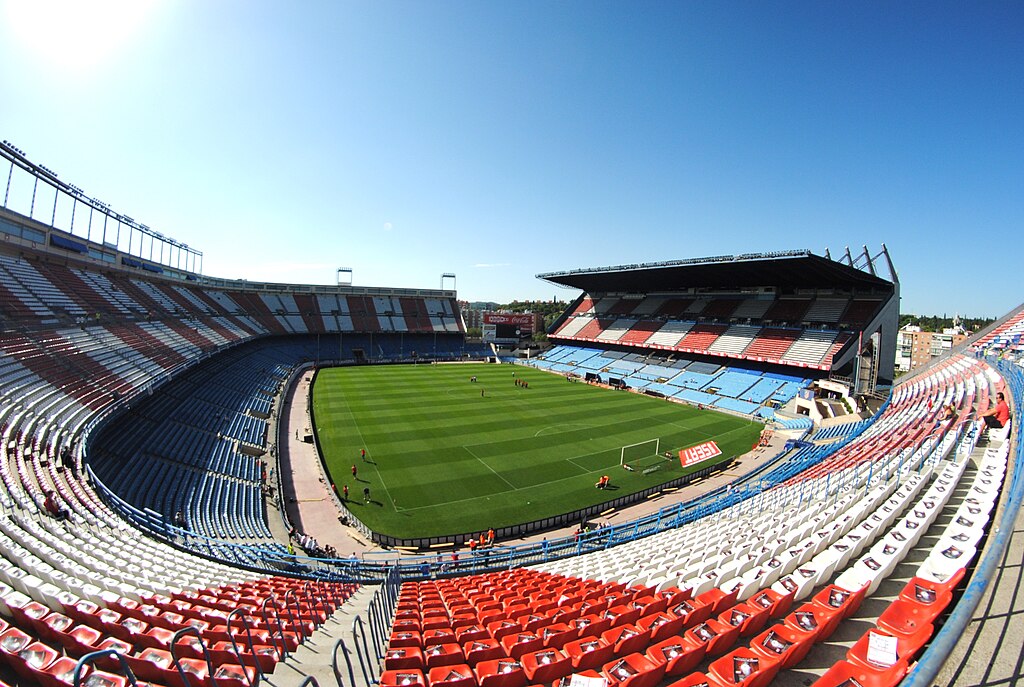
In 1966, the club moved to the Estadio Vicente Calderón, named after the legendary president. Known for its intimidating atmosphere, the Calderón became one of the most feared stadiums in Europe, where passionate fans created an unforgettable energy.
It was here that players like Fernando Torres, Antoine Griezmann and Diego Costa made their mark, and the stadium hosted countless historic Champions League matches and warm derby matches.
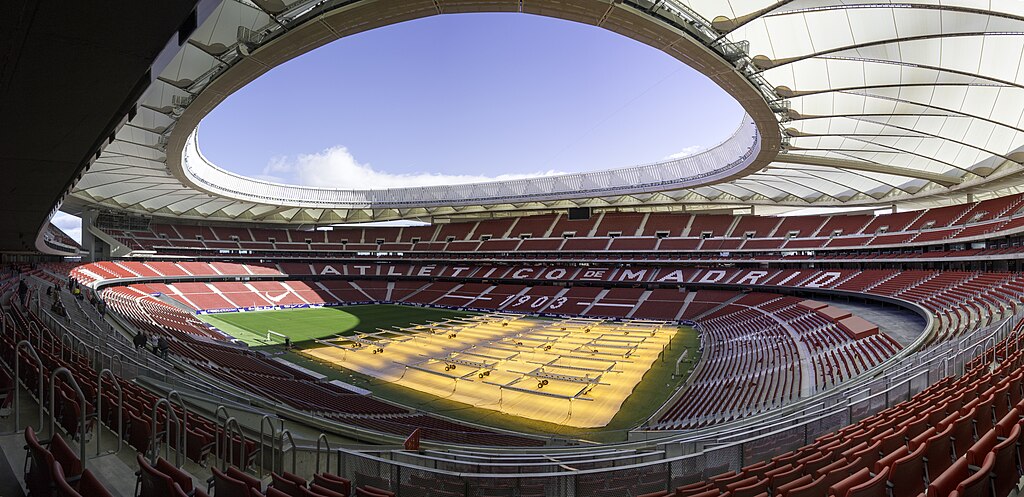
In 2017, Atlético Madrid moved to the Wanda Metropolitano, a modern stadium with a seating capacity over 70,000. This monumental venue symbolizes the club’s ambition while preserving the spirit of its supporters.
The Wanda Metropolitano has quickly become a symbol of the club’s future, with its vibrant atmosphere and passionate fans, still echoing chants like “Aupa Atleti”!
Whether in the stands of the Metropolitano, at the old Vicente Calderón, or during away matches, the energy by Atlético’s fans became an important part of the club’s identity, inspiring the team to continue in the fight for titles.
Make Your Own History with FootballTeam Game
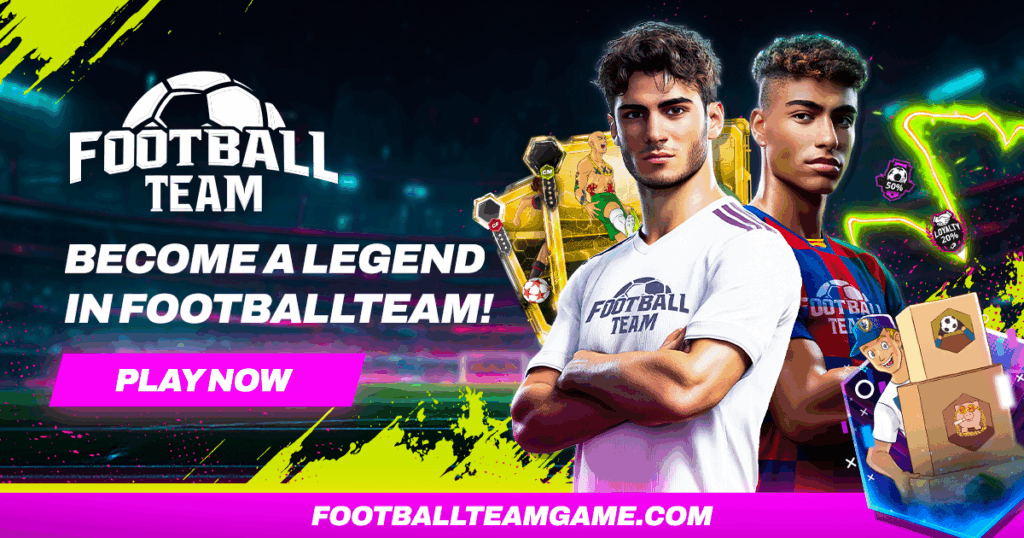
If you’ve made it this far, chances are you’re a big football fan, right?
If you’re passionate about football and want to be the best player ever, I have good news: FootballTeam is the perfect game for you!
This game is your gateway to show off your football knowledge while building your dream team or stadium. Challenge friends and players globally in an immersive football experience like no other!
FootballTeam is available on desktop and mobile devices, ensuring a seamless experience wherever you are. Sign up now and play for free!